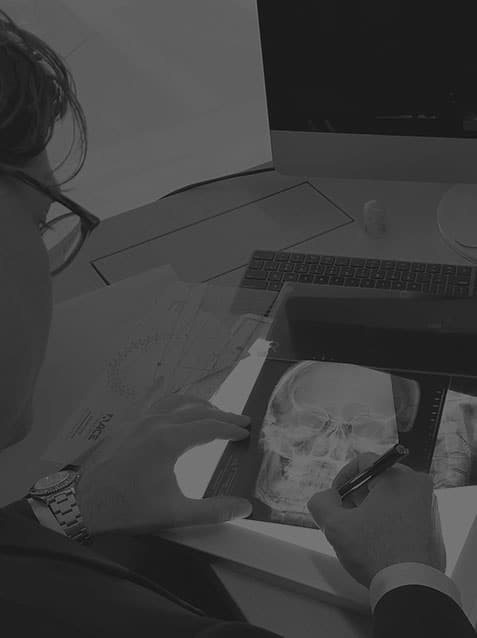Also known as orthognathic surgery, jaw surgeries include several procedures designed to reposition the jaws to improve the appearance, bite, or both. In addition to creating a more appealing jawline, these procedures may also improve function by alleviating a poorly aligned bite, sleep apnea or other breathing problems, or TMJ. Jaw surgeries include:
- UNDERBITE / OVERBITE
- SLEEP APNEA
- LE FORT OSTEOTOMY
- SAGGITAL SPLIT
- DISTRACTION OSTEOGENESIS
- DOUBLE JAW
- JAW SURGERY TIMELINE
- REVISION JAW SURGERY
- LE FORT OSTEOTOMY
Orthognathic Surgery Treats the Following Conditions:
- Class II malocclusion
- Class III malocclusion
- Retrognathia of the upper or lower jaw
- Short face / long face
- Gummy smile
- Small chin
- Assymetries of the face and/or bite
- Dental midline asymmetries
- Bruxism and chewing problems
- Disharmony of facial proportions
Orthognathic or “Corrective” Jaw Surgery Improves Quality of Life
Large improvements may often be obtained by altering the position of the upper and lower jaws. In addition, orthognathic surgery is ideal for young adults who have an over- or under-growth of one half of the jaw. Orthognathic surgery also improves:
- The appearance of the face by improving the harmony of its proportions
- The functional and aesthetic relationship between the teeth so that teeth fit better within the jaw
- The airway: it may be a sole treatment for patients with sleep apnea
- Temporomandibular joint (TMJ) problems in those patients in whom a malocclusion (poor bite) contributes to that TMJ
How Orthognathic Surgery and Orthodontics Work Together
Ultimately, orthognathic surgery, plastic surgery, and orthodontics work together for a successful result. A good relationship and clear communication between your jaw surgeon and your orthodontist is critical because ultimately the two will coordinate the fit of your teeth together, in conjunction with a plan for your surgery. It’s a team effort.
What Are the Alternatives to Orthognathic Surgery?
Some people try alternative procedures to orthognathic surgery to camouflage a poor bite without ever being referred to one of the few specialists who do this type of surgery. For example, patients with a small jaw would vastly benefit by having the lower jaw moved forward. Yet they may have a surgeon with no experience in this type of surgery use a chin implant instead, which is not ideal because this often fails to fix the real underlying problem. In fact, we often need to remove chin implants (chin revision surgery) and move the jaw forward for patients who have had the incorrect procedure in the first place. A chin implant leads to a very pronounced chin and the bottom lip almost lies on top of the protruding chin which is sometimes worse than the original problem! Orthognathic surgery should be considered by anyone before they consider any type of “camouflage” operation so that they know all the facts involved.
New Techniques in Orthognathic Surgery Mean Faster Recovery.
There are new techniques in orthognathic surgery that decrease the swelling and down time associated with larger operations. Using techniques that involve less trauma to the tissue and by using Platelet Rich Plasma PRP at the onset and conclusion of surgery we have had very good success with patients feeling better faster after these operations. One big misconception is that patients will have to have their jaw’s wired shut at the conclusion of surgery. This is not the case in our practice and almost always patients will have light elastic rubber bands to guide the bite at the end of surgery.
How Do Orthognathic Surgery and Plastic Surgery Work Together?
When you are committing to orthognathic surgery, it’s often the right time to consider other aspects that may be beneficial to the structure and look of your face. Augmenting the facial skeleton using bone grafts, or reducing various aspects of the facial skeleton if they are too prominent, are quite often useful adjuncts to these procedures to improve the final result. It’s better to think about these aesthetic considerations when one is already planning for a surgery, rather than doing them as a separate procedure.
How Long Will Recovery From My Jaw Surgery Take?
Initially you may feel discomfort and mild pain, and depending on your individual procedure you may also experience tingling and swelling. We usually prescribe non-opioid painkillers for the first few days after surgery, but after this time over-the-counter pain relief such as Extra Strength Tylenol will work just as well. Most of the pain and swelling will recede within the first few days after surgery. You will be restricted to a liquid diet for at least 1 week. After this time you will be able to start eating soft foods and eventually resume your normal diet.
Will I Need Other Post-operative Treatment?
Depending on your condition and recommended surgery, post-operative therapies may include the surgeon’s collaboration with your orthodontist for further teeth straightening. Dr. Deschamps-Braly will work with your orthodontist and speech therapist to create a collaborative rehabilitation plan.
Why Choose Us?
Many of the doctors who do orthognathic surgery have very little training or concern for the outcome and aesthetic appearance of the face. A crude decision to simply move the jaw forward is made and the procedure is then executed. Coming from an extensive background in plastic surgery, we start with the premise first of an aesthetically balanced result and work backwards from that point towards having a functional result that merges with an aesthetic one.



